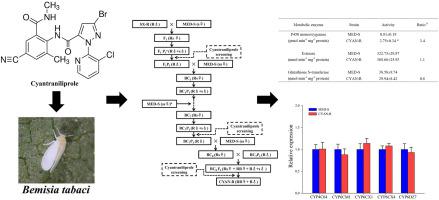当前位置:
X-MOL 学术
›
Pestic. Biochem. Phys.
›
论文详情
Our official English website, www.x-mol.net, welcomes your
feedback! (Note: you will need to create a separate account there.)
Cross-resistance and biochemical mechanism of resistance to cyantraniliprole in a near-isogenic line of whitefly Bemisia tabaci Mediterranean (Q biotype)
Pesticide Biochemistry and Physiology ( IF 4.2 ) Pub Date : 2020-07-01 , DOI: 10.1016/j.pestbp.2020.104590 Ran Wang 1 , Wunan Che 2 , Jinda Wang 3 , Cheng Qu 1 , Chen Luo 1
Pesticide Biochemistry and Physiology ( IF 4.2 ) Pub Date : 2020-07-01 , DOI: 10.1016/j.pestbp.2020.104590 Ran Wang 1 , Wunan Che 2 , Jinda Wang 3 , Cheng Qu 1 , Chen Luo 1
Affiliation

|
Bemisia tabaci, sweetpotato whitefly, is one notorious insect pest on a series of crops worldwide, and many populations show high resistance to various insecticides. The cyantraniliprole-resistant strain of B. tabaci SX-R (138.4-fold) was obtained by selections with an outdoor-collected cyantraniliprole resistant population. By crossing and repeated backcrossing to a susceptible MED-S strain, the trait of cyantraniliprole resistance from SX-R was moved into MED-S to establish one near-isogenic line (CYAN-R). MED-S and CYAN-R were utilized to build patterns of cross-resistance, CYAN-R strain exhibited 63.317-fold resistance to cyantraniliprole, but no cross-resistance to several other successfully commercialized chemical agents. After that significant inhibition of cyantraniliprole resistance by piperonyl butoxide (PBO) and increased cytochrome P450 (3.4-fold) were observed in CYAN-R strain, indicating putative involvement of P450 in detoxification. Furthermore, five published detoxification-related P450 genes in B. tabaci, CYP4C64, CYP6CM1, CYP6CX1, CYP6CX4, and CYP6DZ7 were selected and expression levels of them were measured for exploring mechanisms of cyantraniliprole resistance. Compare with MED-S, no significant overexpression of the five P450 genes was observed in the CYAN-R strain. Above results could be conductive to study on mechanism of cyantraniliprole resistance and will be very helpful for the management of whitefly.
中文翻译:

地中海粉虱近等基因系对氰虫酰胺抗性的交叉抗性及生化机制(Q生物型)
Bemisia tabaci,甘薯粉虱,是世界范围内一系列农作物上的一种臭名昭著的害虫,许多种群对各种杀虫剂表现出很高的抗药性。烟粉虱 SX-R 的抗氰胺苯甲酰胺菌株(138.4 倍)是通过选择室外收集的抗氰胺苯甲酰胺群体获得的。通过与易感 MED-S 品系杂交和重复回交,将 SX-R 的氰虫酰胺抗性性状转移到 MED-S 中以建立一个近等基因系(CYAN-R)。MED-S 和 CYAN-R 被用来构建交叉抗性模式,CYAN-R 菌株对氰虫酰胺表现出 63.317 倍的抗性,但对其他几种成功商业化的化学试剂没有交叉抗性。在此之后,在 CYAN-R 菌株中观察到胡椒基丁醚 (PBO) 对氰虫酰胺耐药性的显着抑制和增加的细胞色素 P450(3.4 倍),表明 P450 可能参与解毒。此外,选择了烟粉虱中五个已发表的解毒相关 P450 基因、CYP4C64、CYP6CM1、CYP6CX1、CYP6CX4 和 CYP6DZ7,并测量了它们的表达水平,以探索氰虫酰胺耐药机制。与 MED-S 相比,在 CYAN-R 菌株中没有观察到五个 P450 基因的显着过表达。以上结果有助于研究氰虫酰胺耐药机制,对粉虱的防治有很大帮助。选择烟粉虱、CYP4C64、CYP6CM1、CYP6CX1、CYP6CX4 和 CYP6DZ7 中 5 个已发表的解毒相关 P450 基因并测量它们的表达水平,以探索氰虫酰胺耐药机制。与 MED-S 相比,在 CYAN-R 菌株中没有观察到五个 P450 基因的显着过表达。以上结果有助于研究氰虫酰胺耐药机制,对粉虱的防治有很大帮助。选择烟粉虱、CYP4C64、CYP6CM1、CYP6CX1、CYP6CX4 和 CYP6DZ7 中 5 个已发表的解毒相关 P450 基因并测量它们的表达水平,以探索氰虫酰胺耐药机制。与 MED-S 相比,在 CYAN-R 菌株中没有观察到五个 P450 基因的显着过表达。以上结果有助于研究氰虫酰胺耐药机制,对粉虱的防治有很大帮助。
更新日期:2020-07-01
中文翻译:

地中海粉虱近等基因系对氰虫酰胺抗性的交叉抗性及生化机制(Q生物型)
Bemisia tabaci,甘薯粉虱,是世界范围内一系列农作物上的一种臭名昭著的害虫,许多种群对各种杀虫剂表现出很高的抗药性。烟粉虱 SX-R 的抗氰胺苯甲酰胺菌株(138.4 倍)是通过选择室外收集的抗氰胺苯甲酰胺群体获得的。通过与易感 MED-S 品系杂交和重复回交,将 SX-R 的氰虫酰胺抗性性状转移到 MED-S 中以建立一个近等基因系(CYAN-R)。MED-S 和 CYAN-R 被用来构建交叉抗性模式,CYAN-R 菌株对氰虫酰胺表现出 63.317 倍的抗性,但对其他几种成功商业化的化学试剂没有交叉抗性。在此之后,在 CYAN-R 菌株中观察到胡椒基丁醚 (PBO) 对氰虫酰胺耐药性的显着抑制和增加的细胞色素 P450(3.4 倍),表明 P450 可能参与解毒。此外,选择了烟粉虱中五个已发表的解毒相关 P450 基因、CYP4C64、CYP6CM1、CYP6CX1、CYP6CX4 和 CYP6DZ7,并测量了它们的表达水平,以探索氰虫酰胺耐药机制。与 MED-S 相比,在 CYAN-R 菌株中没有观察到五个 P450 基因的显着过表达。以上结果有助于研究氰虫酰胺耐药机制,对粉虱的防治有很大帮助。选择烟粉虱、CYP4C64、CYP6CM1、CYP6CX1、CYP6CX4 和 CYP6DZ7 中 5 个已发表的解毒相关 P450 基因并测量它们的表达水平,以探索氰虫酰胺耐药机制。与 MED-S 相比,在 CYAN-R 菌株中没有观察到五个 P450 基因的显着过表达。以上结果有助于研究氰虫酰胺耐药机制,对粉虱的防治有很大帮助。选择烟粉虱、CYP4C64、CYP6CM1、CYP6CX1、CYP6CX4 和 CYP6DZ7 中 5 个已发表的解毒相关 P450 基因并测量它们的表达水平,以探索氰虫酰胺耐药机制。与 MED-S 相比,在 CYAN-R 菌株中没有观察到五个 P450 基因的显着过表达。以上结果有助于研究氰虫酰胺耐药机制,对粉虱的防治有很大帮助。











































 京公网安备 11010802027423号
京公网安备 11010802027423号